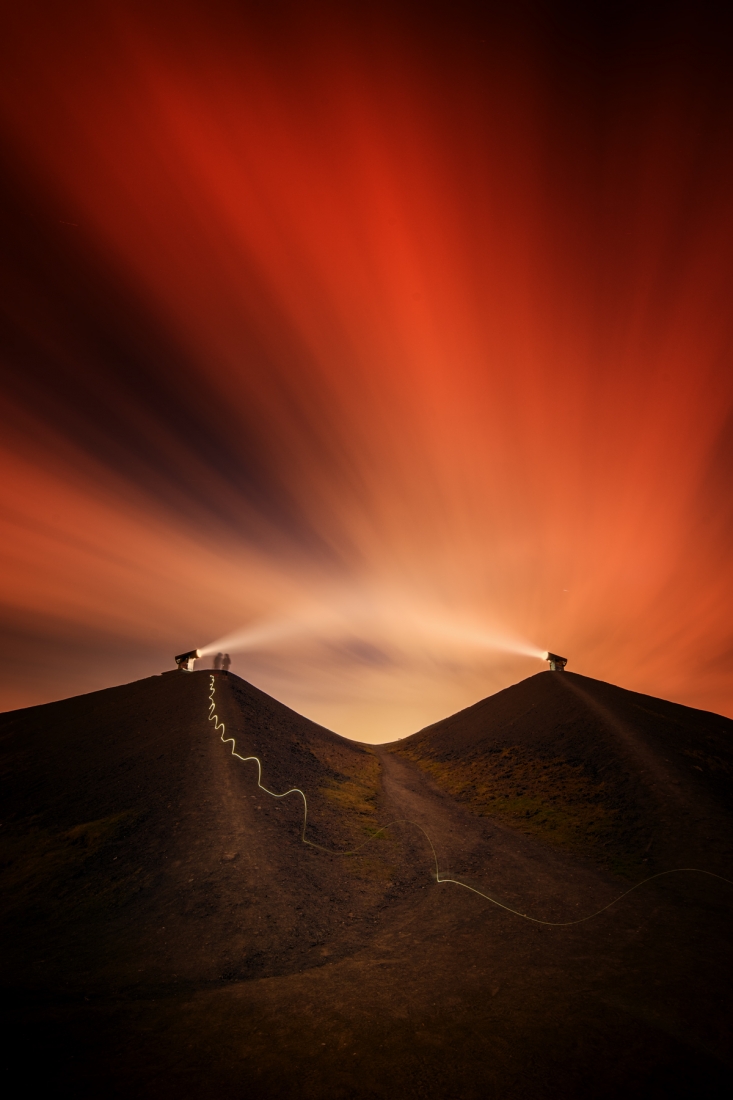2nd place
silver star award
Volker Birke
germany 
Photo © Volker Birke
title
Rungenberg (Industrial Heritage Site)
Nikon D800, Tamron SP 24-70mm F/2.8 Di VC USD, Stativ, LZB, PP in PS CC 2018
Rungenberg, Schüngelberg, Gelsenkirchen-Buer, Ruhr region, by night.
Buona visione.
Volker
P.S. "Tief im Westen" ("Way Down West") is the first verse in German rock/pop singer Herbert Grönemeyer's song "Bochum" featured on "4630 Bochum" (his fifth's studio album released on 14 August 1984, by EMI). The city of Bochum is part of the Ruhr region what has been facing a material decline of the former coal and steel industry since the 70ies and therefore a structural transformation to new industries for several decades now. Rungenberg is a huge overburden of an abanoned colliery called "Hugo". Those floodlights on top of the overburden represent an artwork trying to mark / pointing out to the industrial heritage of the Ruhr region (into the nightly sky and maybe eternity or whatsowever...). ;)
Anyway, I've been fascinated with nature, especially sea and landscapes, all my life, and how it relates to personal feelings, atmosphere and moods. Got my first camera around the age of ten. Therefore, artistic land and waterscape photography has always been a favorite subject, also viewing landscape paintings (e.g., created by Caspar David Friedrich or William Turner). Already as a youngster I got interested in the work of Friedrich (CDF), especially by his masterpiece "Der Morgen" (The Morning"), I remember:
https://de.wikipedia.org/wiki/Caspar_David_Friedrich#/media/File:Caspar_David_Friedrich_-_Tageszeitenzyklus,_Der_Morgen_(1821-22).jpg
However, I'm much interested in other genres of photography as well. For the last ten years I have primarily used digital SLR cameras, though still employing and developing (B+W 35 mm) film occasionally.
More info:
https://www.volkerbirke.com/about-1/
Good statement I like:
"My job as a photographer is to bring order to chaos.
While it's true that our world is full of visual richness, it's also true that our world is full of visual chaos.
The difficulty in creating strong, dynamic photographs is in dealing with that chaos.
Out of an infinite number of elements, I (and you) have to select and arrange a certain number of them into some visual harmony.
Consider the difference between a painter and a photographer.
Starting with a blank canvas, the painter constructs an image by adding only those elements needed for visual excitement.
But my job as a photographer is to eliminate, to strip away many of those chaotic elements that exist in front of me until I arrive at the strongest possible image."
Norton, B. (2001) "The Art of Outdoor Photography - Techniques for the Advanced Amateur and Professional"
back to gallery
entry description
"Tief im Westen (Way Down West)"Nikon D800, Tamron SP 24-70mm F/2.8 Di VC USD, Stativ, LZB, PP in PS CC 2018
Rungenberg, Schüngelberg, Gelsenkirchen-Buer, Ruhr region, by night.
Buona visione.
Volker
P.S. "Tief im Westen" ("Way Down West") is the first verse in German rock/pop singer Herbert Grönemeyer's song "Bochum" featured on "4630 Bochum" (his fifth's studio album released on 14 August 1984, by EMI). The city of Bochum is part of the Ruhr region what has been facing a material decline of the former coal and steel industry since the 70ies and therefore a structural transformation to new industries for several decades now. Rungenberg is a huge overburden of an abanoned colliery called "Hugo". Those floodlights on top of the overburden represent an artwork trying to mark / pointing out to the industrial heritage of the Ruhr region (into the nightly sky and maybe eternity or whatsowever...). ;)
about the photographer
I'm a semi-professional photographer specializing in fine art land and waterscape photography. I can't draw, but release the shutter, sometimes (I suppose), and I'm looking for the harmony of the world, sometimes (I suppose)...Anyway, I've been fascinated with nature, especially sea and landscapes, all my life, and how it relates to personal feelings, atmosphere and moods. Got my first camera around the age of ten. Therefore, artistic land and waterscape photography has always been a favorite subject, also viewing landscape paintings (e.g., created by Caspar David Friedrich or William Turner). Already as a youngster I got interested in the work of Friedrich (CDF), especially by his masterpiece "Der Morgen" (The Morning"), I remember:
https://de.wikipedia.org/wiki/Caspar_David_Friedrich#/media/File:Caspar_David_Friedrich_-_Tageszeitenzyklus,_Der_Morgen_(1821-22).jpg
However, I'm much interested in other genres of photography as well. For the last ten years I have primarily used digital SLR cameras, though still employing and developing (B+W 35 mm) film occasionally.
More info:
https://www.volkerbirke.com/about-1/
Good statement I like:
"My job as a photographer is to bring order to chaos.
While it's true that our world is full of visual richness, it's also true that our world is full of visual chaos.
The difficulty in creating strong, dynamic photographs is in dealing with that chaos.
Out of an infinite number of elements, I (and you) have to select and arrange a certain number of them into some visual harmony.
Consider the difference between a painter and a photographer.
Starting with a blank canvas, the painter constructs an image by adding only those elements needed for visual excitement.
But my job as a photographer is to eliminate, to strip away many of those chaotic elements that exist in front of me until I arrive at the strongest possible image."
Norton, B. (2001) "The Art of Outdoor Photography - Techniques for the Advanced Amateur and Professional"
back to gallery

